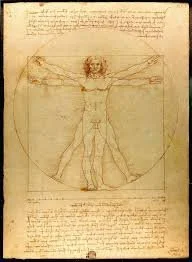post-humanism with Eleanor Dare.
Written by Rickyah Blake
On November 19th, 2024, we had lecturer Eleanor Dare visit the MACA cohort. During this time, we discussed the concept of “post-humanism” and how technology can be used as a source of reframing. The term post-humanism refers to a movement that reflects on the relationship between humans and technology. More specifically, Dare views this movement as an opportunity to liberate the body through recognizing it is an extension of oneself. A reference used during the lecture was the work of Leonardo da vinici’s Vitruvian Man. This image is often referred to in the conversations of post-humanism but typically reveals a homogenous viewpoint of technology and its ability to make “a better and stronger man”. The battle to use technology to improve the lives of able-bodied men sets society up to remain under the thumb of patriarchy and racism. Dare challenges this notion by exploring how technology can help society to move past gender and face.
Vitruvian Man by Leonardo da Vinci (1490)
We looked at research projects that exposed the bias in AI systems. Exploring how AI perpetuates prejudicial bias such as not recognizing Black features or categorizing people’s race and gender based on looks. The systemic and algorithmic bias in AI is a dangerous one but reminds us that they are human made mechanisms. Technologies’ functionality is a reflection of the human that made it. When looking at posthumanism, we must abandon the generic definition applied to the movement. In the rise of technological innovation, one must choose a side that will benefit all human beings, by not supporting the systems reinforcing the ills of modern society.
References:
Ethics Centre, 2023. *Ethics Explainer: Post-Humanism*. [online] Available at: <https://ethics.org.au/ethics-explainer-post-humanism/>

